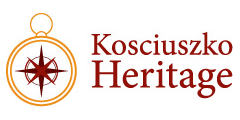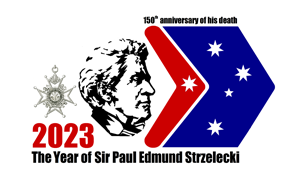The new film produced by Kosciuszko Heritage, P. E. de Strzelecki’s Humanitarian Deeds in Ireland, has been officially publicly released.
Produced by Felix Molski, Ernestyna Skurjat-Kozek, John Molski, Andrzej Kozek and Lukasz Swiatek, the film was distributed on Saturday the 24th and Sunday the 25th of August, at the 2013 International Commemoration of the Irish Hunger held at the Hyde Park Barracks in Sydney.
The annual event, organised by the Great Irish Famine Commemoration Committee, marks the catastrophic famine that took place in Ireland in the 19th century, paying tribute to the millions of individuals who died in it and the scores of individuals who decided to leave workhouses throughout Ireland and undertake long voyages to other countries, including Australia.
The new film from Kosciuszko Heritage focuses on the role played by Sir P. E. de Strzelecki, a Polish philanthropist and explorer who saved hundreds of thousands of children from starvation.
For Felix Molski – a committee member of Kosciuszko Heritage, and the initiator and driver of the project – the effort that went into the production of the DVD was very rewarding.
“Our documentary was well received,” he said. “The positive response was better than expected. In front of an audience of luminaries, Irish Minister of Culture and Gaeltacht Jimmy Deenihan acknowledged Strzelecki’s humanitarian deeds and unequivocally stated that Paul Edmund was instrumental in saving over 200,000 Irish children from starvation in his country’s hour of desperate need. Though many in the audience were somewhat familiar with Strzelecki’s activities in Australia, the announcement of his humanitarianism was a revelation!
“The Minister went on to say that the creation of an official honour roll would be a good idea, where all those who acted as ‘Good Samaritans’ could be recognised. Such a statement, made in Australia on behalf of a great Pole by a significant member of the Irish Parliament, gives pause for thought.”

The audience at the International Commemoration 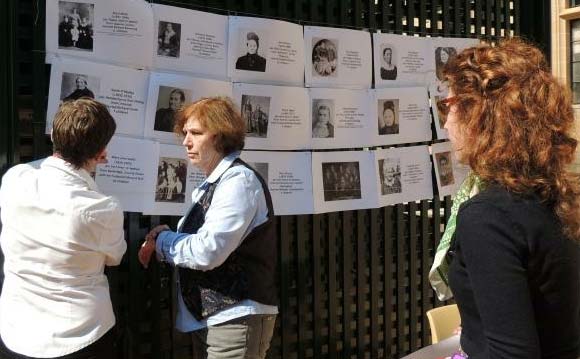
A photo exhibition of the Irish Famine orphans who settled in Australia 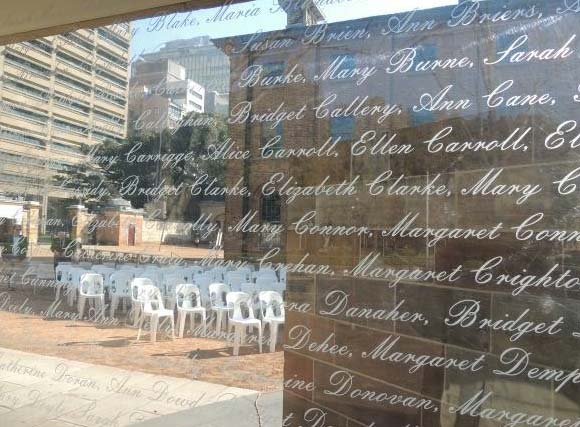
Hundreds of names of the Famine orphans inscribed on the wall 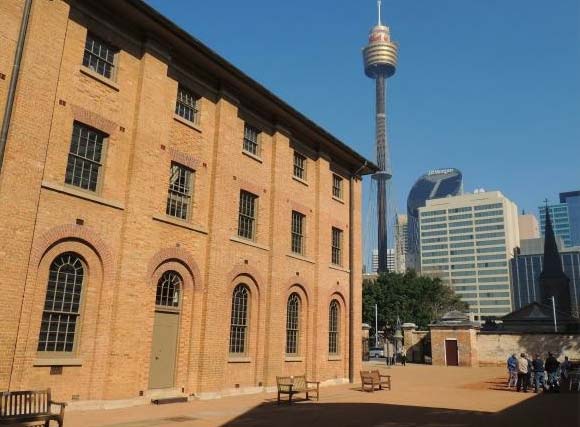
The Hyde Park Barracks in Sydney 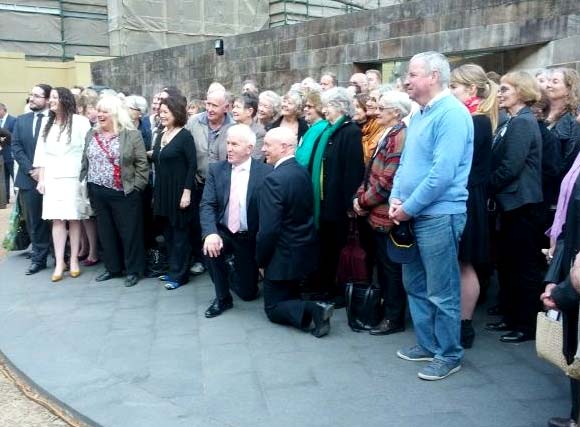
A photo call for the descendants at the Memorial 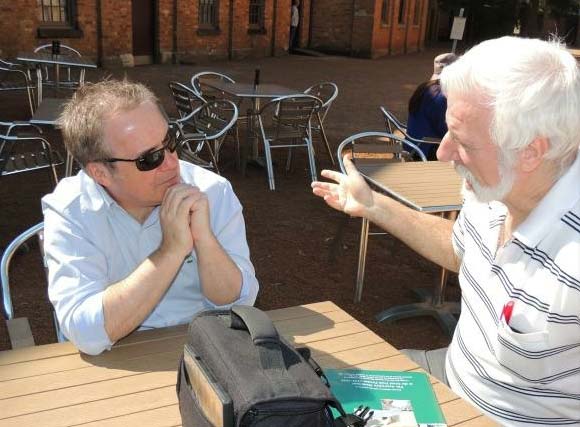
Billy Cantwell of The Irish Echo (left) with Felix Molski (right) 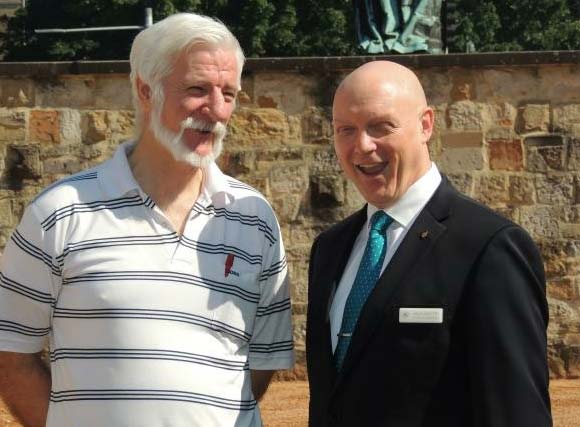
Felix Molski (left) and the Hon. Bryan Doyle (right) 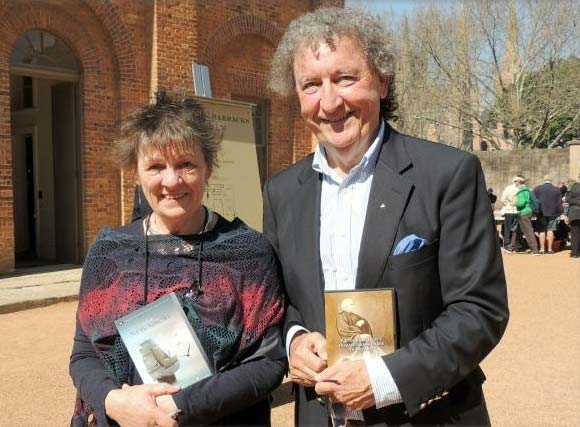
The novelist Evelyn Conlon with Paddy McDonald 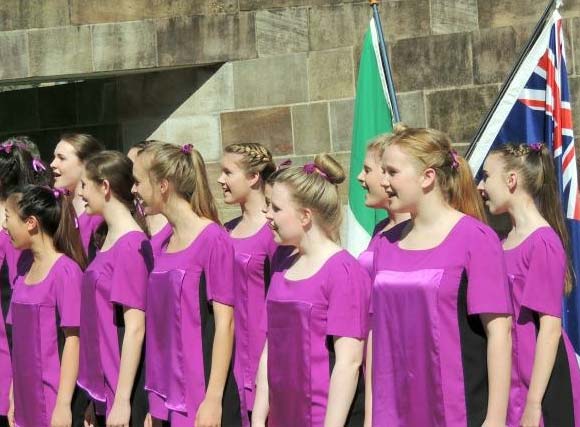
The Australian Girls’ Choir 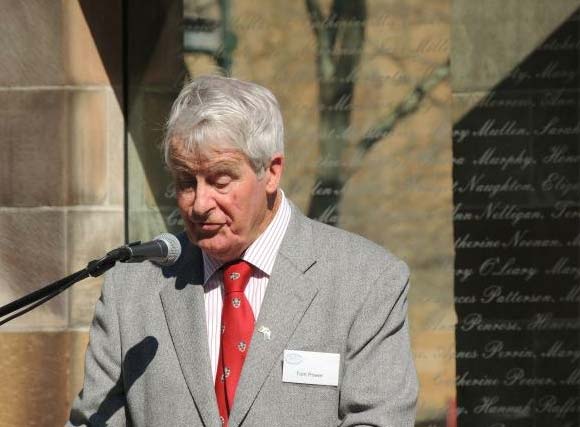
Tom Power, the former Chairman of the Irish Famine Commemoration in Australia 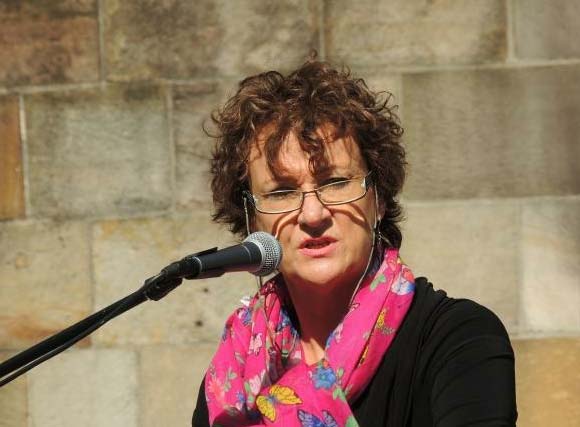
Dr Perry McIntyre, the Chair Great Irish Famine Commemoration Committee 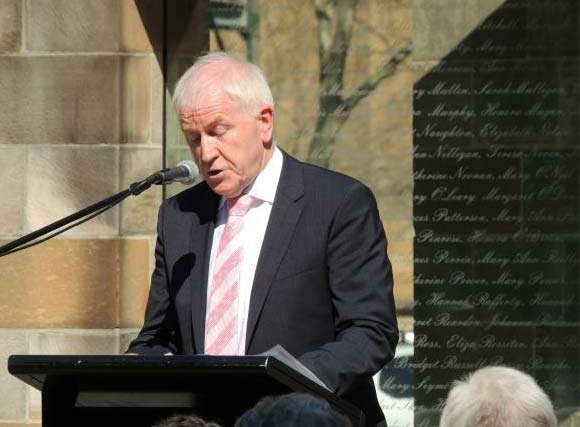
The Irish Minister for Arts, Heritage and Gaeltacht, Mr Jimmy Deenihan 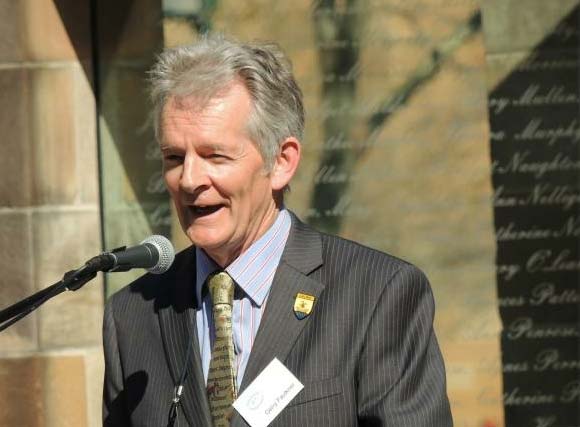
Gerry Faulkner, the MC
Felix’s full thoughts from the event have been published in an article on the Australian-Polish online newspaper Puls Polonii, along with a photo-gallery. The article is reproduced below:
We at Kosciuszko Heritage Inc. are a dedicated group of passionate volunteers who have, for the past 7 years, promoted the legacy of Gen. Thaddeus Kosciuszko and Sir P.E. Strzelecki in Australia and worldwide. In the process of getting the true Strzelecki we became aware that the popular knowledge about him was centred chiefly on his scientific discoveries and his exploration of Australia. Yet it has to be pointed out that that in January 1847 Strzelecki joined the British Relief Association, volunteering his time and talent to help the starving people of Ireland. It is for these humanitarian deeds Strzelecki was knighted by Queen Victoria on November 21st, 1848, only two months after his return from Ireland.
Prelude to the Great Hunger
Centuries of British oppression had pauperised the Irish people. Huge tracts of land had been confiscated and ownership of millions of acres was transferred to what the Irish call ‘The Protestant Ascendancy’ and their allies. The ‘Ascendancy’ not only owned the land, they also controlled the laws. This ‘ruling class’ enacted laws to their own advantage and they were oppressive to Irish culture, creed, language and economic wellbeing. The consequences of unjust land ownership and tenure laws had set the stage for starvation, disease, death and the depopulation of Ireland on a monumental scale. In proportion to population, to this day, it is one of the worst calamities in the annals of human history; Ireland’s population only began to recover 100 plus years after the period of ‘Great Hunger’. The graph from Wikimedia Commons illustrates this point.
We decided that the scale of the Hunger and Strzelecki’s humanitarian role in alleviating the suffering needed to see the light of day. Our first step to achieve this goal was publication of The Best of Human Nature, which was launched during 2012 K’Ozzie Festival at Moonbah. Our latest venture in addressing this issue was production of the documentary P. E. de Strzelecki’s Humanitarian Deeds in Ireland. The key personnel of our team comprised Ernestyna Skurjat-Kozek, Felix Molski, Lukasz Swiatek, John Molski and Andrzej Kozek; a handful of people, a massive task and little time. Good teamwork brought success. The production was done in time for its release at the 2013 International Commemoration of the Irish Hunger held last weekend at Hyde Park Barracks in Sydney.
On my 2012 overseas trip to help illustrate the script I had written, I have gathered material about the Irish Hunger. John and Lukasz, despite busy schedules, found the time to do ‘voice overs’ when they were called to do so at the eleventh hour. Lukasz, even when his help was sought at the last minute, came through, using his creativity to make the beautiful designs in earthy colours that adorn the DVD cover and the disc. I think it’s a nice way of symbolically linking the DVD + Strzelecki + Australia. But, it has to be said, that without Ernestyna’s bulldog tenacity the documentary would not have been completed by the deadline date, nor would it have been of the same quality. Confronted with little time and a plethora of problems she managed to source and assemble images and synchronise them with the recently recorded voice overs, and mix both with whatever suitable and royalty free music she was able to gather together. Thankfully, Roy Eaton replied ‘absolutely’ when asked if portions of some of his Chopin recordings could be used free of charge. Ernestyna did all this while virtually deaf, yet the end result was a professional looking and high quality DVD!
I have met few people as tenacious as Ernestyna. With this attribute she moves mountains – and meets deadlines – miraculously, or maybe she does it through Churchill’s proverbial ‘blood, sweat and tears’. In the early hours of Saturday the 24th of August, Andrzej, Ernestyna and I finished packaging the DVDs on the very morning we wanted to distribute them at the International Famine Commemoration.
The International Commemoration in Sydney
Whether through pain, shame or a combination of reasons, Irish folk tended to avoid the history of Ireland’s Great Hunger; in the words of the event organiser Dr Perry McIntyre, it was ‘a horror to be forgotten’. Things changed in the mid 1990s, around the time of the 150th anniversary of its beginning. A fountain of publications, documentaries, monuments, art works and ceremonies have emerged addressing and analysing the Hunger’s causes and effects from all possible angles and story lines.
To its credit, the Irish Government inspired in 2008 scrutiny of these terrible times through the inauguration of annual commemorations locally and abroad; a city in Ireland twinned with a place where new destinies were forged in the Irish diaspora. In 2012 the International component was staged in Boston and, as the table shows, in 2013 it was Sydney’s turn.
Year – City in Ireland – International City
2008 – Dublin, County Dublin – Nil
2009 – Skibbereen, County Cork – Toronto & Grosse Isle (Canada)
2010 – Murrisk, County Mayo – New York (USA)
2011 – Clones, County Monaghan – Liverpool (England)
2012 – Drogheda, County Louth – Boston (USA)
2013 – Kilrush, County Clare – Sydney (Australia)
Morning Session
Andrzej and I attended the last two days of the event. On Saturday, 24th August, at NSW Parliament House Theatrette, a group of highly qualified and interesting speakers were assembled by Perry McIntyre, President of the Great Irish Famine Commemoration Committee. The talks focused on perspectives about the experiences of the 4114 Earl Grey Hunger orphans in Ireland, their journey across the oceans and their life in Australia. Our DVD was made available prior to the commencement of the seminar and became part of the conversation on and off the stage.
Our documentary was well received. The positive response was better than expected. In front of an audience of luminaries, Irish Minister of Culture and Gaeltacht Jimmy Deenihan acknowledged Strzelecki’s humanitarian deeds and unequivocally stated that Paul Edmund was instrumental in saving over 200,000 Irish children from starvation in his country’s hour of desperate need. Though many in the audience were somewhat familiar with Strzelecki’s activities in Australia, the announcement of his humanitarianism was a revelation! The Minister went on to say that the creation of an official honour roll would be a good idea, where all those who acted as ‘Good Samaritans’ could be recognised. Such a statement, made in Australia on behalf of a great Pole by a significant member of the Irish Parliament gives pause for thought.
Michael Murphy, co-editor of the Atlas of the Great Irish Famine, set the context. He encapsulated twenty years of research through statistical mapping, outlining the causes of the famine and examining its effects on housing, population, language and life during and after the Hunger. His fast paced presentation was compelling and beautifully illustrated with images from the Atlas.
Dr Richard Reid author of Farewell My Children and A Decent Set of Girls followed, giving an interesting account of the Australian/Irish connections, the journey the girls faced, the contrasts between where they left and where they arrived. Richard’s talk got me thinking about the parallels between Irish and Polish histories, but the Irish had one big advantage – the Russians transported Poles to Siberia, whereas the Irish were sent to Australia. Reid concluded that despite problems of settling into a new environment, all in all, life of the orphan girls in Australia was an improvement. Remittances of money ‘back home’ and chain migration were other aspects of this. Another interesting point is that from the very beginning the Irish began to identify themselves as Australian compared to the retained loyalty to England of locals with English roots.
Trevor McLaughlin, retired senior lecturer at Macquarie University and author of Barefoot and Pregnant, who Tom Power praised as being very pro Strzelecki, asked the audience to consider the Irish orphans from a heroic frame of reference. Trevor justified the belief that these women need to be recognised for the challenges they faced in a starkly different land, confronted by problems arising from their place in Australian society and the attitudes of the locals to them. What is important is the way they were able to overcome the adversity they faced and this, above all, is what we should be mindful of.
Afternoon Session
After lunch Megan Martin from the Historic Houses Trust of NSW gave a captivating account of the ‘forensic’ investigation behind the discovery of what the girls wore; the fabric, colour and fashion of their attire. When Megan posed the rhetorical question of ‘how do we know’, I knew the answer would involve rodents bringing materials to their nests, because I recently visited the archaeological work at Montpelier in the restoration of James Madison’s home in the US where similar discoveries were made… the only difference was that at the Barracks it was rats, and at Montpelier it was mice.
In the 90ties the then President of Ireland, Mary Robinson was the inspiration behind the Sydney monument. Her speech challenged the consciences of the Hunger descendants living ‘the good life’ in Sydney. The message was clear: “Treasure what your forebears overcame. They went through hell, survived, and embarked on a perilous journey migrating to Australia in the hope of a better future.” A sense of indebtedness was evoked. Tom Power heard, ‘felt’ and acted. Newly retired with time on his hands he gathered together a group of likeminded people and The Great Irish Famine Commemoration Committee was formed. A Memorial was envisaged, funds were raised, contacts made and a design competition set up for a memorial at Hyde Park Barracks the ‘alpha point’ for the orphans girls of the Earl Grey scheme. The rest is history.
Although Polish sculptor Maria Kuczynska was one of the five finalists from the 43 entries received, the Historic Houses Trust of NSW Sculpture Committee selected the Hossein and Angela Valamanesh entry as the winning design. The artists partly interpreted their work thus:
The main focus of the sculpture design is the dislocation of the Barracks southern compound wall. A section of this wall will be dismantled and rebuilt on a rotated axis. In the space of the demolished wall two glass panels bearing sandblasted inscriptions of women’s names . . . the rotated sandstone wall represents dislocation . . . the table split in two, has on one end a simple bowl with a void in its base that continues through the table. At the other end is a simple institutional table setting with bread and utensils also cast in bronze. This further symbolises the contrast between hunger and comfort which underpinned the role of the Barracks as shelter. The suggestion of continuity in the two ends of the table represents the continuous and evolving relationships between the site and the lives of those who immigrated. The table and the more intimate spaces created within the rotated wall evoke the domestic nature of life and work for the majority of Irish women migrants while their simplicity and sparseness allude to the subject of the Famine.
At first glance I was moved. In my mind’s eye I could see the monument in the city — but the city was in the monument too. The ‘people’ in the glass panels resting in peace, witnessing the progress and basking in the beauty, energy and bounty that surrounds them; anchored at their ‘alpha point’ and, as it turned out, sitting above the Barracks kitchen that fed them all those years ago. The past, present and future shared as one. At the end of Megan Martin’s presentation I was reflecting on my first impression when to my amazement I saw it on the screen. Dr Richard Reid’s photo was being used as an illustration for Tom Power’s talk.
Tom is a brilliant speaker. Commanding voice, expressive tone and humour delivered with perfect timing. He recounted how an initial budget of $3000 evolved into the $300,000 plus real cost; how the monument location controversy was settled by the ‘virtual image’ of orphan girls crying out for food in the face of the Queen Victoria statue in Queens Square! Well, the southern wall of the Hyde Park Barrack’s enclosure, the second option, was chosen. Was it divine intervention? By happenstance the site was directly above the original Barracks kitchen. Rather than laying a stone, the monument was inaugurated on 2nd September, 1998, by the then President Mary McAleese removing a stone from the wall. A piece of the stone has since been used as part of trophies presented to guests of honour.
All praise to Dr Perry McIntyre for assembling such a diverse and interesting group of scholars, their elucidative presentations, as well as making sure the schedule was strictly adhered to. Her own contribution in integrating each speaker’s contributions within the context of the Commemoration was invaluable in maintaining focus. The event ended with the launching of Evelyn Conlon’s historical novel Not the Same Sky. The book was launched by Dr Jeff Kildea, barrister, historian and lecturer at the Global Irish Studies Centre at the University of NSW. Dr Kildea’s insights into the novel added texture and colour to the story of the journeys, experiences and transformation of the orphan girls by means of dimensions a historian cannot provide. A novelist can ‘elaborate, embellish and entertain’ to make the characters ‘real’ whereas historians must stick strictly to interpreting objective facts. In the words of the author, as a novelist she was able to bring birds into the picture, something historians couldn’t do.
Sunday at the Barracks
Andrzej and I returned on Sunday, 25th August for the celebrations and formalities that were scheduled to take place in front of the Irish Famine Memorial at Hyde Park Barracks. It was a day of music, speeches delivered by dignitaries such as Minister Deenihan from Ireland and Hon. Bryan Doyle representing the Premier of NSW, presentations, wreath laying and several addresses by descendants of the 4114 Earl Grey orphans. Novelist, Evelyn Conlon read excerpts from Not the Same Sky. During the activities, Andrzej and I spoke to many people who had viewed the DVD overnight and they were full of praise for the Kosciuszko Heritage production. We were glad to hear so many positive words, especially when coming from people such as Dr Val Noone, an Australian from Victoria who has written extensively about social history and the Irish language; Michael Murphy, co-editor of the Atlas of the Great Irish Famine, the end product of twenty years of painstaking research; and Paddy MacDonald who helped produce The Explorers, a documentary series hosted by Bill Peach that aired on Australian television in the mid 1980’s and included an episode titled ‘The Pinnacle of Fame’ which covered Sir Paul Edmund Strzelecki’s expeditions in Australia. ‘Effervescent’ Paddy, well known as the ‘collector and connector’ (who owns, organises and runs the annual Charlie Chaplin Festival in Waterville, County Kerry, Ireland) was particularly enthusiastic about our documentary and promised to spruik it to the best of his ability.
Where to?
A full stock of our first batch of the DVD evaporated over the course of the two days, grabbed by the people of Irish heritage who had come to pay homage to those who suffered so terribly during the years of the Hunger. A large proportion of the audience were highly accomplished people, especially those who attended the talks in the Parliament House Theatrette on Saturday; historians, authors, researchers, and media representatives amongst others. Copies of the DVD were given to all the visiting dignitaries, speakers and organisers of the event.
In November of this year, Dr Val Noone will be organising the Famine Rock Commemoration Day in his home state of Victoria to honour those who suffered during the mid-nineteenth century Hunger in Ireland. (Val, in 2009, was awarded the medal of the Order of Australia for his many achievements and years of meritorious service). A second batch of the DVD would give us the opportunity to build on the platform established in Sydney of getting knowledge of Strzelecki’s humanitarianism better and more widely known. We at Kosciuszko Heritage can also see many other ways in which this documentary could be used to project to the broader Australian community, and internationally, significant Polish contributions to humanity and the fabric of life.
Felix Molski
